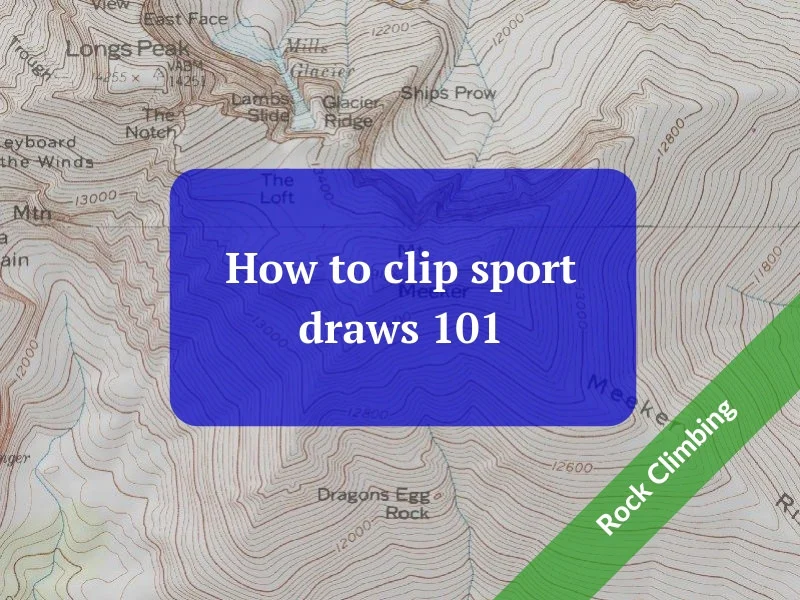
Rock Climbing
When lowering off and cleaning an overhanging route, you may have a problem at the bottom quick draw. If you unclip that and let go, you're probably gonna take a big swing, which may be into something dangerous. Here are two techniques to solve this problem.
Do you enjoy ankle breaking ground fall potential with the crux just before the first bolt? (Smith Rock Oregon, I'm looking at you!) Cool, neither do I. Enter the frugal climber’s stick clip. All you need is a stick, some tape, and a rock.
Are you trying some super-steep sport route? Extending the quickdraws might make clipping easier. Here are two good ways (and two not-so-good ways) to do this.
Do you need to clip a “project” quickdraw that’s already on a bolt? If you have a long stick and know how to tie this crafty double slipknot, it’s easy. Check out the article and video to learn how.
If you want to rig a super long toprope with two strands, here's one way to do it, along with some precautions. Use a static rope for the second line if you have one, you may need to pass a knot when belaying, so be ready to do this, and have solid communication with your partner about the plan.
When clipping a piton, try to clip and then rotate the carabiner so the gate is facing out and the load is along the spine. If that doesn't work, you might be able to skip the carabiner entirely by hitching a sling to the pin.
The Black Diamond Gridlock carabiner is designed to minimize cross loading. When using this carabiner with a Grigri, Black Diamond recommends that you clip the wide part of the carabiner to your harness, and the narrow end to the belay device: opposite the normal way you would use a carabiner.
Need to do some improvised aid climbing to get past a tough section of rock? When the summit is more important than style points, here's a way to tie an improvised aid ladder out of a double and single length sling.
A “nose hooked” carabiner can fail at an extremely low load. Fortunately it's easy to notice and fix, so be aware of this potentially dangerous situation.
Learning how to place rock gear, and want a little assurance that your pro might be able to take some real force? You can learn a lot without getting more than a foot or two off the ground by bounce testing at your local crag.
There's a quick and easy way to revive your rock shoe rubber - Give it a quick scrub with some rubbing alcohol (and maybe sandpaper.)
If you’re leading a sport route at your limit, having the first bolt clipped increases your safety by eliminating a ground fall. With this simple rope trick, the first leader can pre-clip the first bolt for the second leader.
The DMM Pivot is an assisted braking belay device like the ATC Guide, but it has one clever difference - you can easily lower your second without advanced shenanigans.
It's a good idea to protect a fixed rope that's loaded over an edge. Here's a inexpensive and quick way to do it with a short piece of 1 inch webbing.
If you’re out of slings on a long pitch, get creative - stoppers and other trad gear can be used as runners in a pinch.
Every trad climber has been there - Long pitch, lots of pro, and you run out of spare carabiners with only stopper placements between you and the anchor. Can you put a sling directly on that wire? Let's find out.
A unique genre of climbing in Japan is something known as “sawanobori” - following a stream in a canyon upwards, ideally until you reach the source. It's like canyoneering, only in reverse. Watch a fascinating professionally produced 12 minute YouTube video here. Yes, it's about as scary and dangerous as it sounds.
So, this isn't technically rock climbing, but these two short videos will get your blood pumping. Alternative ways to scary yourself on the iconic and amazing central Oregon rock feature, Monkey Face.
I think this is my new favorite climbing video, and it doesn't even have a climber in it. One more reason to love Metolius gear.
If you have two (or more) cams that are the same size, you can clip the racking carabiners to each other to save some space on your harness gear loops.
On a sport climbing quickdraw, you have a choice with the bottom gate; facing the same direction as the top gate, or opposite? The clever climbers at Black Diamond make a pretty good case for one method.
The sewn pocket daisy chain has a potentially lethal problem if you use it as a leash. Hopefully you're aware of this and have retired yours if you ever used it this way. Good news: it makes a pretty sweet gear sling,
When does a good belayer not belay? Before their partner has made the first clip. Avoid this common beginner mistake.
Working on dialing the moves on a sport climbing project, and don't care how many takes you have? Give your belayer and the rope a break by clipping directly to each bolt for a rest.
Use this rock gym employee trick to set up your next outdoor top rope, as long as someone else is climbing there already.
For tagging a lot of routes in one day at the crag, rope bags and tarps are great to keep your rope tangle free and clean. Your Swedish big box store has probably the cheapest piece of climbing gear you're ever going to buy.
Whether you love it or hate it, everyone seems to have some strong opinion of the “pinkie”, the size 0.5 Tri-cam from Camp! Some are even inspired to write a poem about it.
If you have a fixed rope loaded over an edge, giving it some protection can be an excellent idea. Here's how to do it in a few seconds with a 4 foot runner.
The late great Jim Bridwell, Yosemite big wall pioneer, had a unique take on many aspects of climbing. Here's one of his more offbeat contributions - his greatly simplified rating system.
Want to start leading sport routes? Clipping the rope into a quick draw might seem simple when you watch an expert to do it, but there are some subtleties that aren't immediately obvious. Learn a few of them with this instructional video.
Having a standard system to rack gear when you’re cleaning as a second will greatly speed up your climbing efficiency. Here’s a simple way to do this.
When you finish a single pitch sport route, should the last climber rappel off, or be lowered? The debate on this can get pretty hot and heavy, but the momentum is swinging towards lowering. Read why and learn how here.
Don't let your head get big because you can climb “5.11” in the vanity gym. You may be in for a big surprise your first time outside.
You may think that a nut tool is only for the second who’s going to be cleaning the gear. Here's a few good reasons why the leader may want to carry one as well.
If you have a close look at the harness of an experienced trad climber, odds are you’ll find a few tricams. There’s a reason for this. Learn why they may deserve a place on your rack.





































